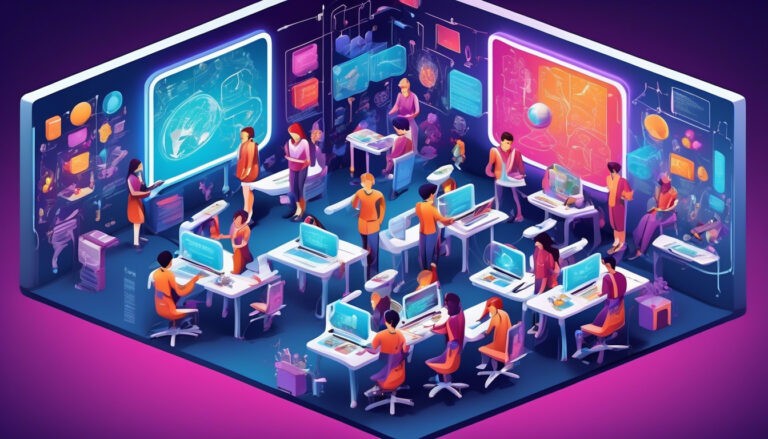As we step into the future, the landscape of education is undergoing a transformative in shift, with AI content tools at the forefront of this evolution. These technologies aren’t just changing how teachers teach and students learn; they’re reshaping the very foundations of educational environments.
From personalized learning experiences to instant content generation, AI tools are set to revolutionize the classroom, making education more accessible, engaging, and effective.
This article explores the potential of AI-driven tools in education, examining both the opportunities they present and the challenges they bring, as we navigate the complex interplay of technology and traditional teaching methods.
Benefits of AI Content Tools
AI content tools can significantly enhance your productivity by automating routine writing tasks. They’ll help you streamline the creation of essays and reports, freeing you up to focus on more complex aspects of your studies. These tools can generate outlines and drafts quickly, which means you’ll spend less time staring at a blank screen and more time refining your ideas.
Moreover, these tools offer personalized feedback on your writing, pointing out grammatical errors and suggesting improvements in style and coherence. This immediate feedback accelerates your learning curve, helping you become a more effective writer faster.
You’re not just completing assignments quicker; you’re also improving your writing skills with every task. AI content tools don’t just make writing easier; they make it better.
Integration into Curriculum
Integrating AI content tools into the curriculum empowers you to harness advanced technology for enhancing your academic performance. It’s about bringing cutting-edge solutions right to your classroom, enabling you to interact with complex information in simplified forms. Think of AI as your personal formant that helps dissect vast amounts of data and present them in an understandable way.
By weaving AI tools into various subjects, you’re not just learning; you’re engaging with interactive content that responds to your input. This approach ensures you’re not passively receiving information but actively participating in your learning process. It makes lessons more dynamic and significantly more applicable to real-world scenarios, equipping you with skills that are immediately valuable and future-proof.
Personalized Learning Experiences
Personalized learning experiences allow you to tailor your educational journey to fit your unique needs and goals. With AI content tools, you can dive deeper into subjects you’re passionate about at a pace that suits you best. These technologies analyze your learning habits and performance, adapting in real-time to challenge you just enough to keep you progressing without feeling overwhelmed.
Imagine a classroom where your assignments and study materials change based on how quickly you’re mastering the content. You won’t waste time on concepts you’ve already conquered. Instead, you’ll focus on areas that need more attention, making your study time more effective and rewarding.
This personalized approach ensures that your educational path is as unique as you are.
Enhancing Student Engagement
Engaging students effectively requires integrating interactive and relevant content into the learning process. You can leverage AI content tools to bring dynamic resources into your lessons, captivating your students’ attention. Imagine history lessons with virtual reality tours, or math classes using real-time data analysis apps. These tools aren’t just flashy; they make learning relatable, tapping into your students’ curiosity.
You’ll also find that incorporating quizzes and interactive modules that adjust to individual learning paces keeps your class more involved. By using AI-driven analytics, you’re not just teaching; you’re engaging.
Remember, the goal is to transform passive listeners into active learners, ensuring they’re not just absorbing information, but interacting with it, making their learning experience deeply personal and far more effective.
Improving Teacher Efficiency
Improving teacher efficiency can significantly enhance both the quality and effectiveness of education. By integrating AI tools into your daily routines, you’ll spend less time on administrative tasks and more on teaching. Imagine AI-powered systems organizing your lesson plans or grading assignments. That’s not all; these tools can offer tailored insights based on student performance data, helping you identify who needs more help and in what areas.
Furthermore, with AI, you can quickly create interactive and personalized learning experiences. This isn’t just about saving time; it’s about making your teaching hours more impactful. As you embrace these technologies, you’ll find that you’re able to address the needs of each student more effectively, making your classroom a dynamic and adaptive learning environment.
Addressing Learning Disabilities
Addressing learning disabilities requires understanding the unique challenges and needs of each student. AI content tools can be tailored to support your diverse learning needs by providing personalized learning experiences. These tools can adapt materials to various learning styles, making subjects more accessible to you.
For instance, text-to-speech features help auditory learners absorb information better, while interactive simulations and visual aids benefit visual learners.
AI also offers continuous feedback, which can identify areas where you might need extra help, allowing for adjustments in real-time. This ensures that you’re not left behind. Moreover, these technologies can reduce the stigma associated with extra support, as they offer discreet assistance tailored just for you, enhancing your learning experience without singling you out.
Ensuring Content Accuracy
Ensuring the accuracy of content is crucial for effective learning and confidence in the material you’re studying. When you’re using AI content tools in the classroom, it’s vital to regularly verify that the information provided is correct and up-to-date. This means cross-checking facts with reliable sources and updating the AI systems with the latest data. You’ll want to involve educators in the process too, as their expertise is invaluable in assessing the accuracy of content.
Moreover, incorporating feedback mechanisms within these tools can help identify inaccuracies quickly. This allows for prompt corrections, ensuring that you’re always learning from precise and vetted information.
Remember, the credibility of your education hinges on the reliability of the content you consume.
Ethical Considerations
When using AI in education, it’s important to consider the ethical implications, including student privacy and data security. You need to be aware of how AI systems handle the information they collect from students. Are these details stored securely? Who has access to them? These are critical questions you must ask to safeguard students’ sensitive data.
Moreover, there’s the issue of bias in AI algorithms. You should question whether the AI tools you’re incorporating in your classroom offer an equal learning opportunity to all students, regardless of their background. It’s your responsibility to ensure these technologies are used fairly and ethically.
Always stay informed about the AI tools you use to maintain a trustworthy educational environment.
How do AI content tools impact the role of teachers in the classroom?
AI content tools enhance teaching by providing personalized learning experiences, streamlining assessments, and offering valuable data insights.
They empower educators to focus on individual student needs, foster creativity, and adapt teaching methods effectively.
What measures are in place to ensure student data privacy when using AI tools?
To ensure student data privacy when using AI tools, you must review privacy policies, seek transparency in data collection, monitor access controls, and prioritize secure data storage.
Always stay informed and advocate for student privacy rights.
How can schools with limited technological infrastructure implement AI content tools effectively?
To implement AI content tools effectively in schools with limited tech, start small.
- Focus on key subjects or grades to streamline resources.
- Train staff on tool usage for maximum impact.
- Gradually expand as infrastructure grows.
Conclusion
In conclusion, AI content tools are revolutionizing education by providing personalized and efficient learning experiences for students. With the ability to adapt to individual needs and enhance teaching methods, these tools are shaping the future of classrooms worldwide.
Embracing this technology can lead to improved academic outcomes and better-equipped students for the challenges of tomorrow.
Get ready to witness a transformation in education with AI as a valuable ally in the learning process.





